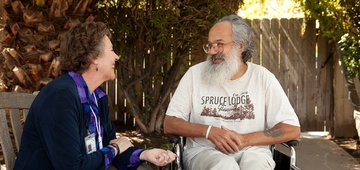
As our population ages and baby boomers reach 65, an increasing number of families will be affected by loved ones with dementia. Dementia is the 6th leading cause of death in the United States. One in eight Americans over the age of 65, or more than 5.3 million people, have dementia. African Americans are at four time's greater risk of developing dementia and Hispanics are two times greater risk.
“When we begin providing care to a patient who has dementia we explore who the patient was before their illness. What is their personality, their likes and interests? What are their values beliefs and culture? This assessment allows us to create a personalized plan of care to follow to bring peace and the most comfort possible to a patient and family,” says Jill Mendlen, RN President/CEO and Founder of LightBridge Hospice & Palliative Care. “Our staff finds special ways to connect with a patient, engaging their senses through sound, color, scent and touch. We share this connection plan with their loved ones and caregivers.”
LightBridge is the only hospice in San Diego to offer the Music & Memory program. Music & Memory is a nationally acclaimed program which brings personalized music to those challenged with Alzheimer's and dementia. With this program, memories are reawakened through the simple and profound experience of listening to one's favorite music with a customized iPod and earphones. Patients with dementia and Alzheimer's are at risk for loss of quality of life and dignity. Our goal is to combine the best practices to alleviate uncomfortable symptoms and use compassionate alternatives to painful interventions.
Dementia is not a specific disease. It's an all encompassing term that describes a wide range of symptoms associated with a decline in memory or other thinking skills severe enough to reduce a person's ability to perform everyday activities: Alzheimer's accounts for approximately 70 percent of cases of dementia. Vascular dementia, which occurs after a stroke, is the second most common dementia type. In addition, there are many other forms of dementia and related conditions that can cause symptoms of dementia. Dementia is caused by damage to brain cells. While symptoms can vary greatly, at least two of the following mental functions must be significantly impaired to be considered true dementia: Memory, communication and language, ability to focus and pay attention, reasoning and judgment, and visual perception. People with dementia may have problems with short-term memory; keeping track of a purse or wallet, planning and preparing meals, remembering appointments or traveling outside of their familiar neighborhood. Many dementias are progressive, meaning symptoms start out gradually, or more suddenly (as sometime occurs following general anesthesia) get worse.
While the challenges of dementia can be heartbreaking, a peaceful, meaningful existence is possible even if a loved one has advanced dementia or Alzheimer’s disease. Dementia is a disease that is life limiting and one that is terminal although some people will die of other illnesses. LightBridge Hospice recognized the unique needs of this population and developed a special dementia program. This program involves training for all of their staff to become dementia specialists, who are then able to provide the best care possible for hospice patients with dementia.
Cindy Hutchinson, RN, Vice President of Clinical Services at LightBridge explains “a person with dementia has generally lost the last 20 to 60 years of their life and is living in another time in their mind. It is helpful to ask the person with dementia how old they are so you know how to respond and make them feel comfortable. If the response is 40 years old and the person is actually 80, you can better understand if they don’t recognize their adult children because in their mind, their adult children are still youngsters. Or the dementia patient may ask for their mom, thinking she is still alive.
Our goal is to provide reassurance and comfort, so we don’t want to say “Don’t you remember? Your mom died years ago.” This response actually makes them relive that sad time. This is why we explore who they were before their illness. If they grew up on a farm we might respond “mom is out on the land”, or you could try asking questions that require only yes or no answers. Did your mom use to go in to town to shop?” “Did she have animals on the farm?” “Did your Mom feed the animals?” This promotes communication and provides the family/caregiver an opportunity to provide comforting reassurance.
It is not uncommon for people with dementia to get agitated or frustrated. When dealing with someone’s agitation it is important to go to their reality, calmly ask where, what, when and how type questions to redirect and calm them down. For example, Cindy shared that one of LightBridge’s hospice patients was convinced she had hair loss. The Lightbridge staff and the patient’s family was encouraged to ask: “when did you first start noticing this, where does the loss seem the worse” or “what do you think might make it better? How about if we try to style your hair this way?” instead of arguing with the patient that she had no hair loss. “It is important to live their truth, identify their feelings and show empathy and respect. Allow for negative feelings to be expressed then redirect and guide the conversation to more positive ones” said Cindy.
Cindy also shared “restlessness of a loved one with dementia will often exhaust the caregiver.” It is helpful to provide a dementia individual with items that promote self-soothing. A body pillow with the cologne or scent of their spouse can bring comfort. Rocking chairs and gliders have also been found to relieve stress and birdfeeders can be a nice distraction. Setting up an area where a loved one can engage in a repetitive activity can help. Some things that have worked well include a table for folding laundry (don’t be surprised if your loved one does this over and over again), pictures to look at or recipes to sort.
It is very common for someone with advancing dementia or Alzheimer’s to have outside hired caregivers. Some families decide to move their loved one to a facility. When a patient is on hospice, LightBridge staff works with the family, caregivers and/or the facility staff to create a plan of care that is customized to the persons needs and stage of disease.
LightBridge staff can help train individuals who may not have a lot of experience in working with persons with advancing stages of dementia. Cindy stated “It is important for caregivers to be calm when they are with your loved one. Observe the caregiver or facility staff. Do they talk slowly with a low pitch (if it is too high pitched it’s more difficult to comprehend). Are they present and kind when interacting? When asking something do they have your loved one’s attention? Do they ask one question at a time and wait for them to process the question and answer? How do they respond when your loved one can’t remember a word or noun? Do they give short, simple and concrete information and break down tasks into steps?” Each of these is important in communicating with a person with dementia.
Moving a loved one with dementia into your home or a facility can be traumatic. “When a person with dementia is moving into a new environment, try to make the room look, feel and smell like them. A common mistake is buying new decorations and furniture; the result is that little is familiar to them so they often will repeatedly request to go home. An evaluation of their living space prior to their move is important to identify areas were the person felt most comfortable.
If they sat on a couch that had a favorite afghan make sure the afghan comes with them to their new home. If they spent time in their bedroom, try to arrange the bedside table and lamp on the same side they are accustomed to it. You can spray their pillow and room with their favorite cologne or perfume for a familiar scent. The less change in environment someone living with dementia experiences, the higher they will function” said Cindy.
Often as people age you will see a change in eating habits. As we age we lose our sense of taste and foods taste bland so more spicy items may be preferred. Bitter is the last taste sense to lose so things that normally tasted good may taste bitter. Sweet is the least prominent taste so they frequently need more sweeteners for food to taste sweet to them. A large plate with too much food may be overwhelming for someone with dementia. Cindy shared that a person’s “vision may be impaired and they are unable to see food directly in front of them. To find out where they can see you can offer their favorite food in a colored bowl and move it around until they reach for it”. Some people forget what utensils are or have difficulty using them, so finger foods are a good option.
Another component of the extensive dementia training LightBridge Hospice staff receives involves the use of a variety of tools to enhance care. These tools include music therapy, re laxation techniques, healing touch, aromatherapy, therapeutic massage, and behavioral management/response techniques. Payment for hospice services is covered by Medicare, Medi-Cal and most insurance plans, however, the costs of many of the therapeutic tools such as aromatherapy and healing touch are not covered. This is where LightBridge Hospice Community Foundation steps in.
LightBridge Hospice Community Foundation is a non-profit organization founded with the thoughtful support of those touched by the care they have received at LightBridge Hospice. The Foundation funds exceptional programs that enhance the end of life journey for all hospice patients. These programs include integrative therapies such as Aromatherapy, Pet Therapy and Healing Touch™ and Simple Gifts, grants for end of life wishes and unfulfilled dreams.
The LightBridge Foundation also provides music therapy through the Norma Sluizer Music Therapy Fund which supports purchasing CD’s and CD players as well as a certified harp therapist. Certified from the International Harp Therapy Program in San Diego, LightBridge’s harp therapist is trained to find the “resonant tone of individuals and then use an improvisational method of attending to a person based on their resonance”. Their harpist has attended specialized training for interacting with patients with dementia. Patients consistently experience positive results from the music therapy program. In one instance, a dementia patient who had been very agitated passed away peacefully within an hour of the visit with the harpist surrounded by family. The LightBridge Hospice clinical teams consistently witness positive measureable results including lowered blood pressure, decreased heart rate, reduced anxiety, and increased mood elevation from music therapy and the other programs supported by the mission of LightBridge Hospice Community Foundation. Moreover, these specialized programs enhance peace of mind, dignity and comfort during otherwise difficult moments.
LightBridge has been a leader in developing specialized programs for families experiencing their end of life journey. The dementia program is just one example. Jill Mendlen, LightBridge President/CEO commented “our clinical teams are committed to making the journey as gentle and peaceful as possible for all hospice patients”.
The LightBridge Hospice Community Foundation continues to fulfill its mission with the support of donors, individuals, corporations and foundations. On Sunday, October 20, the LightBridge Foundation Walk will take place at NTC Park in Liberty Station in San Diego. This year’s theme will be focused on Veteran’s with special displays and demonstration. Proceeds from the walk will contribute to specialized programs for those facing their end of life journey.
For more information about LightBridge Hospice & Palliative Care please call (858) 458-2992 or visit their website www.lightbridgehospice.com. For more information on the LightBridge Walk or the LightBridge Hospice Community Foundation, please call 858.500.7545, email contact@lbhcf.org or visit the website at www.lbhcf.org.



